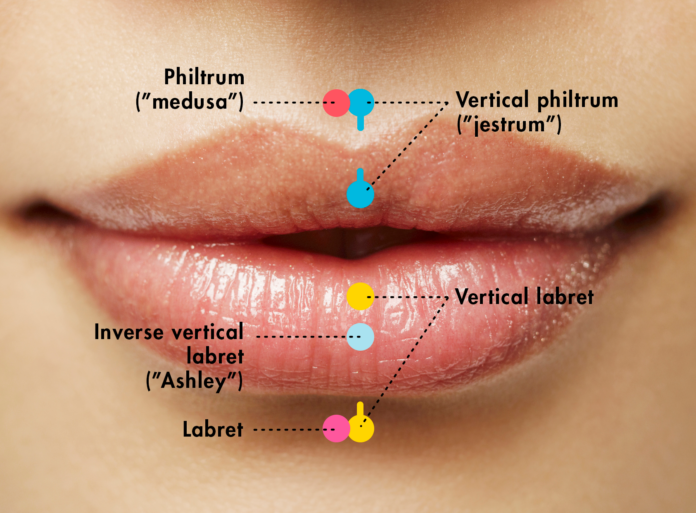The vertical labret piercing, unlike the regular labret piercing, which goes from inside to outside below the bottom lip, is on the outside of the bottom lip.
This vertical labret piercing stands out and offers a great option for colourful and personalized jewellery or if you simply love piercings. But before getting it, talk to your piercer about whether it suits your lips and face shape and how to take care of it while it heals.
If you’re interested, keep reading for a complete guide on the procedure, what to expect during and after, and how to deal with any side effects. The vertical labret is a unique and eye-catching lip piercing choice, setting it apart from the regular labret.
What is Vertical Labret Piercing?
The vertical labret piercing is different from the regular labret piercing. Instead of one hole below the lip, it has two holes through the lip itself, below where a normal labret piercing would be.
The special thing about the vertical labret is that it never touches the inside of the mouth. This means the jewelry won’t scrape against your teeth and gums like other lip piercings, and it stays cleaner during healing since it avoids contact with saliva bacteria.
The vertical labret might be a better choice if you have concerns like receding gums or enamel wear. Also, the vertical labret piercing is a great option if you want a unique and bold style.
Remember to have the piercing done by a professional using a needle. The exact method may vary, but they usually mark the skin, hold the lip with forceps, and pierce it downward with the right size needle.
But not everyone can get a vertical labret piercing. Before getting it, do research and talk to your piercer. They will consider your face shape and any previous changes to see if it’s suitable for you. Trust your piercer’s advice for the best results.
The Procedure for Vertical Labret Piercing
Make sure to visit a certified professional piercer who works in a shop regularly inspected by the health department. It’s essential to check online reviews to ensure the shop’s reputation.
The process of getting this piercing is swift and involves the following steps:
- The piercer will cleanse your lower lip using a disinfectant solution and water.
- You’ll be asked to rinse your mouth with an antibacterial mouthwash to ensure it’s free from harmful bacteria.
- The piercer will mark the areas inside and outside of your lip where the piercing will be placed.
- Using a special tool, they will gently hold and pull your lip outward to get a clear view inside your mouth.
- A needle will be carefully and quickly pushed through the marked areas from top to bottom, ensuring minimal discomfort.
- The needle will then be removed slowly and gently.
- Finally, the piercer will insert the chosen jewelry, such as a bent barbell, into the newly pierced area, and may also add beads to keep it securely in place.
Vertical labret piercing Pain And Healing Time
The vertical labret piercing may be slightly more painful than other lip piercings because it involves two puncture points on the sensitive lip skin.
However, the pain level varies from person to person and is usually moderate. Finding an experienced piercer who can help you through the process is essential.
During the 6-8 week healing period, some swelling, light bleeding, and throbbing are normal. If you experience excessive symptoms, consult a professional piercer.
The good thing about the vertical labret piercing is that it stays outside the mouth, making aftercare easier. Keep your hands and surroundings clean, use antiseptic mouthwash, and avoid submerging the piercing in water.
Remember, everyone’s pain tolerance and healing time are different, but the vertical labret piercing generally heals relatively faster due to its external placement and limited contact with saliva.
Vertical labret piercing: For a quicker healing process and to avoid infections
Here are some essential guidelines to follow during the healing process of your vertical labret piercing:
- Be mindful of the foods you consume, as certain spicy oils can lead to discomfort around the piercing area. After eating, ensure no food residue is stuck in or around the new piercing.
- Refrain from kissing or engaging in oral activities while your piercing heals. Kissing can introduce harmful bacteria and irritate the skin surrounding the piercing, potentially leading to complications.
- Avoid using chapstick or lipstick during the healing period. It’s best to avoid foreign substances near the piercing to prevent infections.
- Ensure that the jewelry you wear during the healing phase is large enough to accommodate potential swelling. Swelling is common in the initial days, and using appropriate jewelry size prevents it from becoming embedded in the skin.
Vertical Labret Piercing Aftercare: Essential Tips for Healing
To take care of your vertical labret piercing, clean it regularly with a saline solution that only contains salt and water. Avoid using tea tree oil or other additives, as they can cause irritation and slow healing.
During the first few weeks, be careful if you tend to bite or play with your lips. Try not to touch or twist the jewelry until the piercing is fully healed. Don’t lick your lips or fiddle with the jewelry to help it heal properly.
Here are some tips for faster healing:
- Clean the piercing 2-3 times a day with a sterile saline solution.
- Avoid touching the jewellery too much, except when cleaning it.
- Keep skincare products and makeup away from the healing piercing.
- Don’t rotate the jewelry; it’s not necessary.
- Refrain from smoking or drinking alcohol for at least two weeks after the piercing to prevent irritation.
Remember, your lips are more sensitive during the healing process, so be cautious not to cause any damage to the piercing. Avoid lip biting or pulling to prevent the jewellery from getting tugged.
Potential Side Effects and Precautions of Vertical Labret Piercings
Before getting a vertical lip piercing, it’s essential to consider a few important things. First, make sure to choose a skilled practitioner who uses gloves and sterile, new, disposable needles for hygiene and safety. Also, check the regulations and licensing requirements in your state to ensure the piercing studio follows the necessary guidelines.
When it comes to potential side effects and complications of a vertical lip piercing, here are some things to keep in mind:
Rejection
Sometimes, the body might treat the piercing as a foreign object and try to push it out, which could lead to scarring and increase the risk of infection.
Tooth or gum damage
The jewelry in the piercing may rub against your teeth or gums, causing damage and decay if not taken care of promptly.
Infection
Lip and mouth piercings have a higher risk of infection as oral bacteria can easily enter the pierced area, especially after eating, drinking, or touching your mouth.
Scarring
Piercings that are rejected or left empty may result in the buildup of thick scar tissue.
Swelling
Some mild swelling and pain are normal in the first few days after the piercing, but if they persist for weeks or become severe, it’s essential to consult a doctor.
Nerve disruption
Facial piercings have been associated with nerve disruption in the face, which can cause back pain and misalignment of the eyes.
Taking these factors into account can help you make an informed decision about whether a vertical lip piercing is right for you.
Vertical Labret Piercing Cost: What to Expect
The cost of a vertical labret piercing can vary a lot, ranging from $30 to $100.
It’s important to choose an experienced piercer for this type of piercing. They can make the process less painful and ensure the piercing is aligned properly, reducing the risk of complications like rejection.
Always go for a piercer who uses a needle, not a piercing gun. Needles are more accurate, hygienic, and gentler on the skin, providing a better and safer piercing experience.
Changing Your Vertical Labret Piercing: A Complete Guide
Changing a vertical labret piercing can be done by unscrewing the ball end from the curved barbell and carefully sliding the jewellery through the piercing hole.
However, due to the long piercing tunnel, it might be tricky to do it yourself. It’s best to seek help from your piercer to avoid any problems.
For this type of piercing, curved barbells are commonly used, usually in 14G or 16G size with internal threading for smoother insertion. You’ll wear longer starter jewelry made of titanium to accommodate swelling during healing.
After healing, you can switch to nickel-free 14k gold curved barbells for a more permanent look. You can get creative with different types of curved barbells, adding charms or using unique materials like pearls or opal.
If you change your jewelry at home, ensure your piercing is fully healed. If unsure, ask your piercer to help you and show you the proper way. Always be careful when changing jewelry and avoid doing it over a sink to prevent losing any small pieces.
Different Styles of Vertical Labret Piercings
You can opt for a horizontal labret piercing instead of a vertical one. In this piercing, both holes are on the lip, and the curved barbell balls are placed side by side.
Like the vertical labret, the horizontal labret also has two holes that don’t go inside the mouth. The piercer will insert the needle horizontally through the lip, giving the appearance of a double-pierced lip with only one actual piercing.
This type of piercing also uses a curved barbell with smaller ball ends.
What Type of Jewelry Is Used for a Vertical Labret Piercing?
The vertical labret piercing offers different types of jewellery, such as:
- Fully enclosed rings or hoops: These go around the entire piercing like an earring in the earlobe.
- Curved barbells: Thick rods with beads on each end that bend around the lips.
- Vertical labret bars: Bars that go through the piercing vertically with a bead on each end, and you can have two side by side for a double-pierced look.
Most vertical labret piercing use a 14G or 16G curved barbell. Start with longer titanium jewellery to accommodate swelling, and later switch to nickel-free 14k gold for a more permanent option.
You can get creative with your curved barbell by choosing different bead sizes or adding charms like pearls or opals. The curved barbell slightly bends outward to fit the shape of your lips.
What Jewelry Material Is Used for a Vertical Labret Piercing?
When it comes to choosing jewellery for vertical labret piercings, you have several options available:
- Implant-grade stainless steel: This type of jewellery is commonly used for vertical labret piercings because of its customizable nature and high quality.
- Titanium: Medical-grade titanium is highly recommended as a metal choice. It serves as an excellent alternative to surgical steel since it doesn’t contain nickel, avoiding any potential cons.
- Gold: Regardless of the gold type – yellow, rose, or white gold – it’s crucial to ensure it’s at least 14 karat and no higher than 18 karat to ensure its solidity and prevent bacteria buildup.
More Body Piercings
Double Nose Piercing: A Complete Guide
Nose Piercing 101: Everything You Need to Know
Getting Your Ears Pierced at Target (Through Rowan)
Ashley Piercing: Everything You Need to Know About Eye-Catching Lip Piercing
Ashley Piercing Scar: Every Thing you Need to know About Ashley Piercing Scarring
The Labret Piercing: Everything You Need To Know
Conclusion
If you’re a fan of showing off your piercings and seeking a unique body modification, the vertical labret piercing could be a perfect choice. It stands out from the regular labret piercing with its two holes through the lip and external placement.
Before getting the piercing, consult with a professional piercer to ensure it suits your lips and face shape, and learn about proper aftercare during the healing process.
The vertical labret piercing is a striking and eye-catching option, allowing you to explore various jewellery styles and materials. Remember, always prioritize safety and hygiene when choosing jewellery for this piercing.
FAQs Vertical labret piercing
Q – Is a vertical labret better for your teeth?
A – Vertical labrets are such cute piercings, and while they are more limited in jewelry then a traditional labret they also avoid all the risks to your teeth and gums. That makes these a popular choice for many who want a lip piercing but don’t want to risk their teeth and gums.
Q – What are the variations of vertical labret piercings?
A – You can opt for a horizontal labret piercing, where both holes are on the lip with curved barbell balls placed side by side, creating a double-pierced look with only one actual piercing.
Q – Is the rejection of vertical labret piercings common?
A – Clients considering a vertical labret piercing should be aware that this type of piercing is essentially a surface piercing on the lip, making migration a common occurrence, and in some cases, the piercing may fully reject.
Q – Does a labret make your lips look bigger?
A – A vertical labret goes vertically through the bottom lip like the labret. This will accentuate your lip shape, making your lower lip look even fuller.
Q – What is the difference between a lip piercing and a vertical labret?
A – While a traditional labret piercing goes through the bottom of the lip and into the inside of the mouth, a vertical labret piercing goes vertically through the lower lip. With this piercing, both ends of the jewellery are visible, and a curved barbell is worn.




